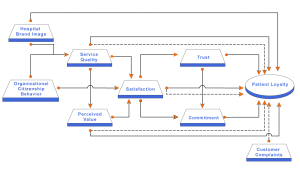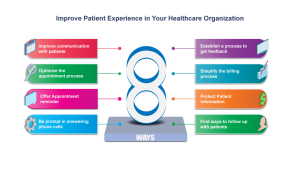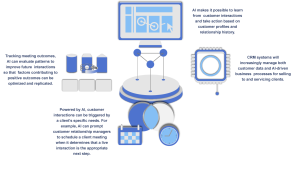Patient loyalty is a key to continued practice success in terms of both recurring and new revenue. Patient loyalty and profitability are crucial for the success of healthcare organizations. Building patient loyalty must be part of the standard patient care program because loyal patients show better and quicker outcomes. As patients return to your practice, you maintain revenue stability; as patients refer their friends and families, your practice billing collections grow. In terms of profitability, the new patient acquisition is more expensive than loyalty maintenance for existing patients by order of magnitude.
Factors Affecting Patient Loyalty
The image below shows how different factors affect patient loyalty. Based on various studies, the image highlights the relationship between these determinants and patient loyalty. The determinants discussed include patient satisfaction, service quality, perceived value, trust, commitment, hospital brand image, organizational citizenship behavior (OCB), and customer complaints. Satisfaction, service quality, and trust are key direct factors influencing patient loyalty, while other determinants may have indirect effects mediated by patient satisfaction, commitment, or other variables (Zhou et al, 2017).

These can be achieved by:
- Timely and proper communication, follow-ups, and feedback
- Smoother and more convenient services
- Providing a patient portal with advanced technology
Timeliness of Communications
Time delay is a major problem of eroding patient loyalty. By the time you discover that you have a patient loyalty problem, it’s typically too late to do anything about the patients who have already left. Patients typically desert you without saying goodbye, and your only way to discover patient attrition is by observing lower collections and more free time on your appointment scheduler.
Frequent patient communication is the only effective way to reduce such a delay and increase the likelihood of timely loyalty problem identification and resolution (Kathy, 2018). Such patient communications can revolve around practice management components— from patient scheduling to SOAP notes to special healthcare literature to medical billing, insurance payments, co-pays, patient education, and deductibles.
Active patient loyalty management, based on selective patient identification for targeted communications at the patient’s convenience, is one of the most effective ways to improve practice profitability. (Why do healthcare providers need to focus on patient loyalty? https://infermedica.com/blog/articles/patient-loyalty-in-healthcare)
Patient Identification for Targeted Communications
It’s convenient to view targeted communications from the patient visit perspective:
- Patients due for scheduled appointments or who owe you payments need a reminder.
- Patients who recently had an appointment need results, interpretation, prescriptions, and follow-up.
- Patients with prescriptions about to expire may need to schedule a visit.
- Patients who have not had an appointment for a long time need a reminder to schedule a checkup. A screening procedure schedule should be generated using specific combinations of procedure (CPT) and diagnosis (ICD) codes.
- Patients with chronic conditions or permanent injuries need literature about recent progress in treating their conditions.
- Patients who have had a long series of appointments need progress reports.
- Patients who receive good progress reports need to be solicited for referrals.
- Patients with bad progress reports need special literature and special appointments.
- Patients waiting in the reception area need access to customized information about their conditions.
- Patients who are at risk of non-compliance, chronic condition exacerbation, or need frequent follow-ups or hospital readmissions
To generate such lists of patients, your systems must combine scheduling, medical notes, and billing data in a single database. Social media has also become an integral part of human life. You can attract and convert potential clients on social media by utilizing the right techniques, such as targeted advertising, engaging content, and active community management. This enhanced digital presence can result in increased brand visibility, expanded reach, and, ultimately, improved financial outcomes (Builders, 2020).
Ways to enhance the patient experience
- Improve communication with the patients
- Optimize the process to schedule new appointments
- Provide appointment reminders
- Promptly reply to patient queries and issues (Karen, 2022)
- Take regular patient feedback to engage with the patient
- Simplify the billing process for patients
- Protect patient information
- Follow up with patients
 Patient Communication Portal
Patient Communication Portal
While traditional phone and conventional mail systems are still in use, digital technology such as social media, software and AI are better choices for communicating with patients. A custom, HIPAA-compliant patient portal is also the least expensive way to allow patients to interact with you outside the clinic at their convenience and privacy. A reliable patient portal can help your patient do the following (What Is a Patient Portal? | HealthIT.gov):
- Review reminders and schedule appointments.
- Review visit and medical test results
- Ask you clarifying questions
- Request prescriptions
- Read special literature and progress reports that you send them
- Send you referrals
- Review medical bills and pay invoices
- Track their medical costs
- Telecommunication and messaging option
The added transparency and convenience reduce administrative burdens, enhance patient satisfaction, and improve revenue collection efficiency by fostering a better understanding of bills, encouraging prompt address of concerns, and reducing unpaid bills. Here are the essential features of patient portals (Desai, 2023):
a) Online Appointment Scheduling
The convenience of online appointment scheduling allows patients to plan, reschedule, or cancel appointments with healthcare providers. By optimizing appointment scheduling based on provider availability, patient preferences, and urgency of care, patient portals enhance efficiency, reduce administrative demands, and improve patient satisfaction.
b) Secure Access to Personal Health Records
Patients can access their medical history, treatment plans, lab results, and more through the patient portal. This empowers patients to make informed decisions about their treatment while protecting their personal health information in compliance with HIPAA regulations.
c) Access to Test Results and Medical History
Patient portals provide easy access to test results, such as blood tests and imaging studies, enabling patients to stay informed about their health status and engage in meaningful conversations with healthcare professionals. Comprehensive medical history records further facilitate care coordination across providers, enhancing patient involvement and outcomes.
d) Secure Messaging between Patient and Provider
Secure messaging functionality enables confidential and compliant communication between patients and healthcare providers. Patients can discuss treatment plans, address concerns, and seek clarification, fostering trust and efficient information exchange within the patient portal’s secure environment.
e) Billing and Insurance Information Management
Patient portals simplify the management of billing and insurance-related tasks. Patients can access and pay medical bills, update insurance information, and track claim progress, ensuring transparency and organization in healthcare financial obligations.
Use of Advanced technology and AI-powered software
Software platforms and AI-powered technologies enable the delivery of personalized messages, appointment reminders, and relevant health information to patients. This can be achieved by collecting and analyzing patient data, including name, age, gender, medical history, previous visit, experience, preference, and current health (Patzer, 2023):
- Engage with the patients and recommend personalized education on preventive measures, screenings, or lifestyle modifications
- Allow patients to conveniently access their medical records, test results, and appointment schedules. Provide personalized preventive care reminders and medication refill alerts to existing patients.
- Identify patients who are at risk of non-compliance, chronic condition exacerbation, or need frequent follow-ups or hospital readmissions. Communication technologies can be used for personalized patient communication (Nayak, 2023).
- Use AI-powered virtual assistants, such as chatbots, to provide round-the-clock support to the queries of both existing and potential new patients. These chatbots can also assist potential new patients with quicker and easier appointment scheduling and offer basic medical advice based on their entered medical data (SolvEdge).
- Analyze the patient’s data in real-time and identify abnormalities that may require medical attention to send immediate alerts to the patient’s family and the healthcare provider (David, 2023).

References:
- How AI in Healthcare is Revolutionizing (and Improving) Patient Engagement and Adherence. (2020, August 24). Retrieved June 14, 2023, from CapeStart website: https://www.capestart.com/resources/blog/how-ai-in-healthcare-is-revolutionizing-and-improving-patient-engagement-and-adherence/
- How AI in healthcare transforms patient engagement. Retrieved June 14, 2023, from Solvedge.com website: https://www.solvedge.com/AI-Healthcare
- Karen. (2015, March 12). Secrets of patient engagement and loyalty. Retrieved June 14, 2023, from Rendia website: https://rendia.com/resources/insights/secrets-patient-engagement-loyalty/
- Kathy. (2018, October 23). Patient loyalty: How to build and maintain relationships in the new age of healthcare. Retrieved June 14, 2023, from Healthcare Success website: https://healthcaresuccess.com/blog/patient-experience/patient-loyalty.html
- Nayak, N. Artificial intelligence in healthcare: Transforming patient experience. Retrieved June 14, 2023, from Classicinformatics.com website: https://www.classicinformatics.com/blog/artificial-intelligence-in-healthcare-transforming-patient-experience
- Patzer, A. (2023, January 20). Ensuring better patient experience and outcomes through artificial intelligence. Retrieved June 14, 2023, from Forbes website: https://www.forbes.com/sites/forbestechcouncil/2023/01/20/ensuring-better-patient-experience-and-outcomes-through-artificial-intelligence/?sh=61125e4c38a9
- Practice Builders. The art of patient loyalty – 4 tips for building a practice patients love. Retrieved June 14, 2023, from Healthcare Marketing Agency website: https://www.practicebuilders.com/blog/the-art-of-patient-loyalty-4-tips-for-building-a-practice-patients-love/
- Why do healthcare providers need to focus on patient loyalty? Retrieved June 14, 2023, from Infermedica.com website: https://infermedica.com/blog/articles/patient-loyalty-in-healthcare
- Zhou, W.-J., Wan, Q.-Q., Liu, C.-Y., Feng, X.-L., & Shang, S.-M. (2017). Determinants of patient loyalty to healthcare providers: An integrative review. International Journal for Quality in Health Care, 29(4), 442–449. doi:10.1093/intqhc/mzx058
- What is a patient portal? | HealthIT.gov. (n.d.). https://www.healthit.gov/faq/what-patient-portal
A Future Book Publication Note:
This article is a chapter in the forthcoming 2nd Edition book “Medical Billing Networks and Processes,” authored by Dr. Yuval Lirov and planned for publication in 2024. We will post more chapters on this blog soon.





